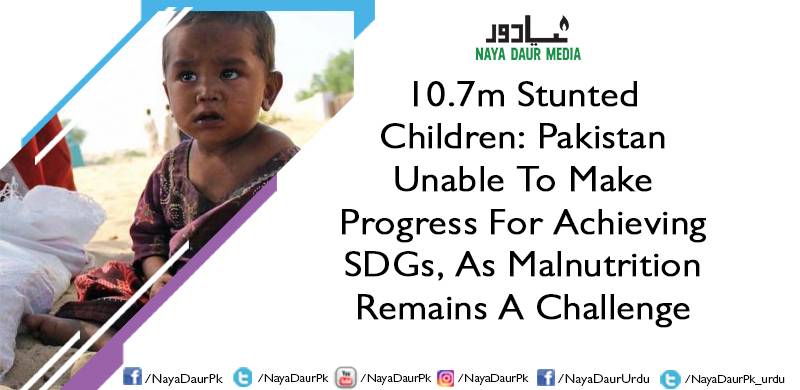
Despite abundance of food, child malnutrition is rife in Pakistan. Four in 10 children under 5 years of age are stunted in the country, according to a government survey, DW says in a report.
According to the National Nutrition Survey which assessed the nutritional status of 115,500 households across Pakistan for the years 2018-19, one in every three children is underweight.
The primary focus of data collection was on children under the age of 5, adolescent girls, and women of child-bearing age.
According to the World Health Organization's (WHO) child growth standards, stunting is a harmful complication of malnutrition and can simply be defined as being shorter than the average height for one's age.
And the Global Nutrition Report 2018 says there are 10.7 million stunted children in Pakistan. Owing to widespread poverty, many families cannot afford a nutritious diet with the recommended intake of protein, fat, minerals and vitamins.
The United Nations' Sustainable Development Goals (SDGs) require that governments worldwide end hunger, achieve food security and improve nutrition by 2030, particularly for the poor and vulnerable sections of society, including infants.
The national survey results, however, reveal that no considerable progress has been made on these fronts in the country. Four out of every 10 children aged under five are stunted, while nearly five million children in the same age group suffer from wasting, or low weight for their height. In total, 18 per cent of the children aged under five suffer from wasting.
The survey also showed that nearly 13 per cent of children between the age of two and five years faced some form of functional disability. Furthermore, one in every eight adolescent girls and one in every five adolescent boys suffered from being underweight, while over half of adolescent girls were anaemic.
Ram Ratan, the medical superintendent at the main hospital at Mithi, Sindh, has been witnessing the malnutrition crisis for the past several years. He said many children in the region fall victim to malnutrition and undernourishment because of the weakness of their mothers, many of whom have delivered several babies without enough gap between pregnancies.
"Mothers' poor nutrition and diet patterns are the major causes of babies' death and malnutrition," he said.
This is compounded by Pakistan's patriarchal culture and gender-based discrimination, say observers. In most households, women often have less food to eat than their male relatives. And the cultural norm of women eating after the male members of the family finish their meals as well as young-aged marriages has also contributed to the problem.
Bearing large numbers of children from a young age not only takes a toll on women's health, but also impacts the well-being of the fetus and the ability to breastfeed a newborn.
"Children who are born small due to poor maternal nutrition start life with a huge disadvantage. Stunting, for example, is one of Pakistan's biggest nutrition-related challenges, and has its roots in pregnancy when mothers do not get adequate nutrition," Aida Girma, country representative for the UNICEF in Pakistan, told DW.
According to the National Nutrition Survey which assessed the nutritional status of 115,500 households across Pakistan for the years 2018-19, one in every three children is underweight.
The primary focus of data collection was on children under the age of 5, adolescent girls, and women of child-bearing age.
According to the World Health Organization's (WHO) child growth standards, stunting is a harmful complication of malnutrition and can simply be defined as being shorter than the average height for one's age.
And the Global Nutrition Report 2018 says there are 10.7 million stunted children in Pakistan. Owing to widespread poverty, many families cannot afford a nutritious diet with the recommended intake of protein, fat, minerals and vitamins.
The United Nations' Sustainable Development Goals (SDGs) require that governments worldwide end hunger, achieve food security and improve nutrition by 2030, particularly for the poor and vulnerable sections of society, including infants.
The national survey results, however, reveal that no considerable progress has been made on these fronts in the country. Four out of every 10 children aged under five are stunted, while nearly five million children in the same age group suffer from wasting, or low weight for their height. In total, 18 per cent of the children aged under five suffer from wasting.
The survey also showed that nearly 13 per cent of children between the age of two and five years faced some form of functional disability. Furthermore, one in every eight adolescent girls and one in every five adolescent boys suffered from being underweight, while over half of adolescent girls were anaemic.
Ram Ratan, the medical superintendent at the main hospital at Mithi, Sindh, has been witnessing the malnutrition crisis for the past several years. He said many children in the region fall victim to malnutrition and undernourishment because of the weakness of their mothers, many of whom have delivered several babies without enough gap between pregnancies.
"Mothers' poor nutrition and diet patterns are the major causes of babies' death and malnutrition," he said.
This is compounded by Pakistan's patriarchal culture and gender-based discrimination, say observers. In most households, women often have less food to eat than their male relatives. And the cultural norm of women eating after the male members of the family finish their meals as well as young-aged marriages has also contributed to the problem.
Bearing large numbers of children from a young age not only takes a toll on women's health, but also impacts the well-being of the fetus and the ability to breastfeed a newborn.
"Children who are born small due to poor maternal nutrition start life with a huge disadvantage. Stunting, for example, is one of Pakistan's biggest nutrition-related challenges, and has its roots in pregnancy when mothers do not get adequate nutrition," Aida Girma, country representative for the UNICEF in Pakistan, told DW.
